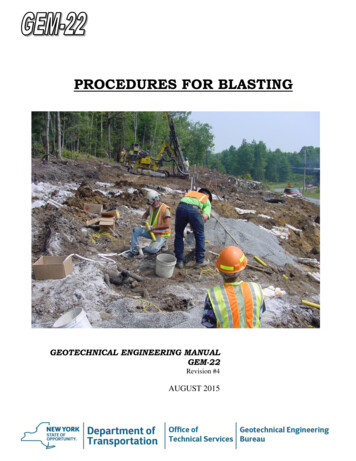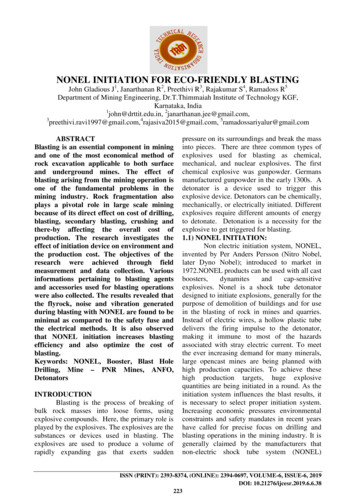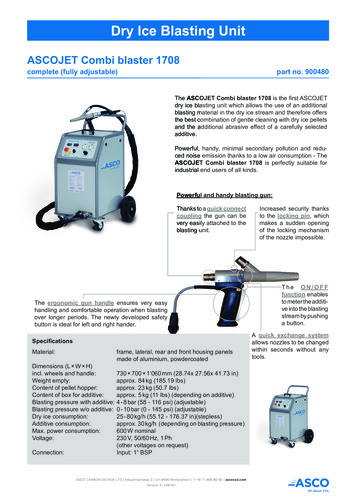
Transcription
PROCEDURES FOR BLASTINGGEOTECHNICAL ENGINEERING MANUALGEM-22Revision #4AUGUST 2015
GEOTECHNICAL ENGINEERING MANUAL:PROCEDURE FOR BLASTINGGEM-22Revision #4STATE OF NEW YORKDEPARTMENT OF TRANSPORTATIONGEOTECHNICAL ENGINEERING BUREAUAUGUST 2015EB 15-025Page 1 of 17
TABLE OF CONTENTS1. INTRODUCTION.3A. Purpose .3B. General .3C. Definitions .62. PROCEDURES FOR BLASTING WITHIN NYSDOT ROW .14A. Submittal of Written Blast Plan .14B. Scheduling Preblast Meetings .15C. Conducting Preblast Meetings .15D. Inspection and Documentation .16E. Test Blasts .16F. Blasting Progress Meetings .16G. Blasting Review .16APPENDICES .17A. Preblast Meeting Itinerary . A-1B. General Guidelines for Project Inspectors .B-1C. Blasting Report Form SM 469 (US Customary Units) .C-1Blasting Report Form SM 469 (International System of Units) .C-2D. Instructions for Filling out the Blasting Report Form . D-1E. Highlights from State and Federal Safety Regulations . E-1F. Geologic Evaluation of Test Section . F-1EB 15-025Page 2 of 17
1. INTRODUCTIONA. PurposeThis document specifies the procedure that shall be followed when a Contractor or Permittee isproposing to blast. By following this procedure, the Engineer-In-Charge or the Permit Engineercan help ensure that the Contractor accomplishes the work in a safe and effective manner.Engineering Geologists from the Geotechnical Engineering Bureau are trained and experiencedin blasting safety and blasting techniques, and are available to provide assistance during allphases of the blasting operations. Prior to blasting the Contractor shall submit a written blast planto the Engineer for conditional approval. The Engineer will forward the blast plan to theEngineering Geology Section, Geotechnical Engineering Bureau for review and writtencomment. After approval of the blast plan, a preblast meeting will be held which shall beattended by the Engineer, the Contractor, the Project Blaster(s), an Engineering Geologist fromthe Geotechnical Engineering Bureau, and representatives of all interested Agencies to discussthe proposed blasting operations. Final approval to blast will be granted based upon the results ofthe meeting. Test blasts may be required and may result in modifications to the blast plan. Allblasts on Department contracts will be documented by the Engineer using the Blasting ReportForm SM 469 US Customary Units (GE 469 International System of Units) (See Appendix C).B. GeneralPresplit blasting is required on State ROW when the design rock slope is one vertical on onehorizontal or steeper and the vertical height of the exposed rock slope exceeds 5 ft. (1.5 m). Thecontract documents may also specify blasting. The Contractor may choose to use productionblasting in conjunction with required presplit blasting or for general rock excavation. TheContractor may also elect to use blasting for trenching operations, structure excavations, andstructure demolitions. Permit jobs that involve blasting on State ROW are subject to the samerequirements as Department-let contracts. If the Permit Engineer is concerned or uncertain aboutthe effects of blasting adjacent to State ROW, the Engineering Geology Section should becontacted for advice.Blasters in New York State are required to posses a valid New York State Department of Labor(NYSDOL) issued Blaster Certificate of Competence. The Blaster Certificate of Competencepermits the use of explosives specific to the following blasting operations. These are classifiedas follows: A Class A (Above\Below Ground) Certificate or Class B (Aboveground) Certificateis required for rock blasting. A Class D (Demolition) Certificate is required for demolition ofbridge superstructures or substructures. A Class E (Seismic) Certificate is required for seismicsurveys. In conjunction with a Blaster Certificate of Competence an Explosives License is alsoneeded for the licensee to purchase, own, posses or transport explosives.The blaster will conduct all blasting operations in a skillful manner so as not to cause injury,damage property, adversely affect traffic, or cause the migration/accumulation of noxious gases.Blasting activities can have negative consequences which include the following:1. FlyrockFlyrock can cause serious injury or damage when it travels outside the blast zone. Flyrockcan be caused by: improper blast design; improper or insufficient stemming;EB 15-025Page 3 of 17
unanticipated geologic features such as voids, soft seams, and other planes ofweaknesses; borehole deviation; insufficient burden; and poorly distributed explosives.The Blaster should inspect any free rock faces for irregularities and geologic conditionsthat may affect the blast and adjust the drill hole locations accordingly. Profiling the rockface using simple measuring tapes, conventional surveying techniques, or more advancedlaser profiling may be warranted. Driller’s notes and logs should be kept and used by theBlaster to make adjustments to explosives loading to account for geologic conditions andborehole deviation. The use of Borehole Deviation Surveys may be feasible to determineboreholes that have wandered too close to each other or too close to the rock face.Monitoring of drilling operations will also provide feedback to the drillers so that theymay make adjustments to their methods.Flyrock can also be controlled by using blasting mats or soil cover to retain the explodedrock. It’s important that the Blaster make sure that all personnel are outside the blastingarea where fly rock can be expected.2. VibrationsBlasting generated vibrations can damage underground and aboveground structures.When the Contractor is using a seismograph to monitor vibrations on State ROW, theStandard Specifications (§203-3.02.A.3.) provides the maximum particle velocity unlessdirected otherwise by the Engineer or the Contract Documents. In the absence of seismicmonitoring equipment, the explosives loading limits shall be based upon the scaleddistance formula in the Standard Specifications. In certain circumstances, NYSDOTcontract documents may also require monitoring of adjacent structures that are off theState ROW. NYSDOL regulations (12 NYCRR 61) restrict vibration levels at buildingsin the vicinity of blasting operations based upon distance or vibration frequency. Evenwhen vibrations are not at a level sufficient to cause damage, they can disturb individualsand result in complaints. Proper placement and operation of the seismograph is critical forobtaining accurate readings. Vibrations can be controlled by modifying the weight ofexplosives per delay, the loading density, and the delay pattern. A preblast conditionsurvey of a structure may be required prior to blasting.3. Displacement of BedrockBlasting, primarily trench and ditch blasting, can displace rock and damage adjacentpavement and underground utilities.4. Noxious FumesBlasting generates carbon monoxide and other noxious fumes. The fumes generatedduring blasting operations, especially during trenching operations, can migrate and collectin excavations, manholes and D.I.’s, and nearby buildings. The build up of significantconcentrations of gases can occur 12 hours or more after the blast. All blasting shall beconducted so that the noxious gases generated by the blast do not affect the health andsafety of individuals.EB 15-025Page 4 of 17
When site conditions and blasting procedures indicate that there is the potential for themigration and accumulation of gases, the Contractor should specify informationcollection activities, modification of blasting procedures, and an action plan in the eventof a high reading or alarm. Such site conditions could include but are not limited to: openjointed bedrock (i.e. karstic limestone); an impermeable soil layer overlying the bedrock(i.e. clay or saturated soil); and proximity to buildings. Blasting procedures that mayincrease the risk include confined (i.e. trenching), large, and frequent blasts. Informationcollection activities should include preblast surveys of all buildings within a minimum of300 ft. (100 m) of the blast, which would identify potential sources of entry and potentialpathways to the buildings such as buried utility trenches. Information collection activitiesshould also include monitoring of carbon monoxide levels before, during, and after theblast. Modification of blasting procedures should include limiting the size and frequencyof blasts to limit the production of noxious fumes, and stripping of the overburden priorto blasting and excavating the shot rock immediately after blasting to allow the venting ofgases. The use of vent holes or vent pits may also be necessary. The action plan shouldcover both building occupants and monitoring personnel.5. Airblast OverpressureAlthough unusual, blasting generated air waves can reach a level where they can damagebuildings. NYSDOL (12 NYCRR 61) specifies limits for airblast levels at buildings inthe vicinity of blasting operations. Air waves not at a level sufficient to cause damagecan disturb individuals, resulting in complaints. Factors that affect air blast overpressureinclude topography, blast design, and atmospheric conditions. Blasts may have to beredesigned or rescheduled for more favorable atmospheric conditions to minimize airwaves.6. MisfiresMisfires happen when a loaded hole, portion of a loaded hole, or several loaded holes failto detonate during a blast. Misfires can be caused by failure of the detonation system orby explosive column cutoffs. Sometimes it is apparent immediately after a blast that amisfire has occurred. Other times it’s not discovered until the blasted rock is beingexcavated and unexploded explosives are discovered within the shot rock pile. TheBlaster-in-Charge is responsible for checking the shot immediately after the blast formisfired holes and, if discovered, re-detonating the loaded holes. If re-firing a misfiredhole presents a hazard, the explosive may be removed by washing out with water or, ifunderwater, blown out with air. No drilling or digging shall be permitted until all missedholes have been addressed. When unexploded explosives are discovered mixed in withthe shot rock, excavation will cease until a Project Blaster is notified and he is able tosupervise the continued rock excavation and proper disposal of the unexplodedexplosives. All personnel involved with excavating shot rock should be vigilant for thepresence of unexploded explosives.Each Certified Blaster is required to report to the NYSDOL any unusual incident or event thatoccurs during the blasting operations. They are also required to report any instances of prematuredetonation, damage from air blast, damage from excessive ground vibration, or instances of flyrock. Damage must be reported even when it is alleged and/or the complaint is made after aEB 15-025Page 5 of 17
substantial lapse of time.C. DefinitionsAirblast - The airborne shock wave generated by an explosion.ANFO – A blasting agent composed primarily of ammonium nitrate and fuel oil.Authorized Blasting Assistant – An individual who has been authorized by the certified blasterin-charge to work on a blasting operation after such blaster-in-charge has confirmed that theindividual is either a certified blaster, or otherwise meets the following qualifications:(1)Is at least eighteen years old;(2)Has been properly trained in the performance of the tasks to be assigned; and(3)Has been made aware of and understands the blasting hazards and risks.Backbreak – Rock broken beyond the limits of the last row of holes in a blast, synonymous withoverbreak.Base Charge – The main explosive charge in the base of a detonator or a heavy charge at thebase of a column of presplit powder.Battered Production Holes – The row of production holes closest to presplit line, drilled at thesame angle as the presplit holes.Bench – A horizontal ledge from which holes are drilled downward into the material to beblasted.Binary Explosive – A blasting explosive formed by the mixing of two plosophoric materials, forexample, ammonium nitrate and nitromethane.Blast Pattern – The plan view of the drill holes as laid out for blasting.Blast Plan – A written procedure that details the methods and manner by which a Project blasterwill comply with pertinent laws, rules, regulations, and contract documents. The plan shallinclude all information, as detailed in Section 2A, necessary to evaluate the effectiveness andsafety of the proposed blasting operations. Individual blasts on a project are rarely identical. Theplan should show the details for a typical blast with the understanding that minor modificationsin the field will be allowed. Significant changes to the blasting operations will require that a newblast plan be submitted for approval. When deemed necessary by the Engineer, approved blastplans will be required for each individual shot.Blaster-in-Charge – The Project Blaster in charge of a specific blast. Responsibilities includedelivery of explosives, storage, loading, and detonation of the blast. A project may have severalProject Blasters, but only one blaster is in charge of each blast.EB 15-025Page 6 of 17
Blasting Agent – An explosive material, consisting of fuel and oxidizer that can’t be detonatedwith only a No. 8 blasting cap.Blast Area – An area near any blasting operation in which concussion, flying material or debris,or gases resulting from a detonation of explosives can reasonably be expected to cause injury orproperty damage.Blasting Galvanometer – An electrical resistance instrument designed specifically for testingelectrical continuity of electric detonators and circuits containing them. Other acceptableinstruments for this purpose are Blasting Ohmmeters and Blaster’s Multimeters.Blasting Mat – A Mat of woven steel wire, scrap tires, or other suitable material to coverblastholes for the purpose of preventing flyrock.Blasting Site – The specific place defined by the Blaster-in-Charge where explosives are used inblasting operations. A blast site is part of the blast area.Blasting Superintendent – The Contractor may use a Blasting Superintendant to providegeneral oversight for drilling and blasting operations. However, the Blaster-in-Charge isresponsible for each blast.Blasting Vibrations – The energy from a blast that manifests itself in the form of vibrationswhich are transmitted through the earth away from the immediate blast area.Booster – An explosive charge, usually of high detonation velocity and detonation pressure,designed to be used in the explosive initiation sequence between an initiator or primer and themain charge.Bulk Strength – The strength per unit volume of an explosive calculated from its weightstrength and density.Burden – The distance from the borehole to the nearest free face or the distance betweenboreholes measured perpendicular to the spacing.Certified Blaster – An individual who has been issued a “Blaster Certificate of Competence” bythe NYSDOL for using explosives.Collar – The mouth or opening of a borehole.Column Charge – A long, continuous, unbroken column of explosives in a blasthole.Continuity Check (Circuit) – A determination that an initiation system is continuous andcontains no breaks or improper connections that could cause stoppage or failure of an ignitionsystem. For an electric initiation system, the check is performed both visually and by using ablasting galvanometer or other device. For a non-electric initiation system, the check can only bedone visually.EB 15-025Page 7 of 17
Deck Loading (Decking) – A method of loading blastholes in which the explosive charges,called decks or deck charges, in the same hole are separated by stemming or an air cushion. Theseparate decks may or may not be fired on the same delay.Deflagration – An explosive reaction such as a rapid combustion that moves through anexplosive material at a velocity less than the speed of sound in the material.Delay Blasting – The practice of initiating individual explosive decks, boreholes, or rows ofboreholes at predetermined time intervals using delay detonators, or other delaying methods, ascompared to instantaneous blasting where all holes are fired essentially at the same time.Delay Detonator – An electric or nonelectric detonator used to introduce a predetermined lapseof time between the application of a firing signal and the detonation of a charge.Departmental Engineering Geologist – An Engineering Geologist of the GeotechnicalEngineering Bureau authorized by the Director of the Geotechnical Engineering Bureau toperform the duties required under the NYS DOT Standard Specifications. EngineeringGeologists are trained and experienced in blasting safety and blasting techniques, and areavailable to provide assistance during all phases of the blasting operations.Design Rock Slope – A cut slope in rock constructed at the angle and location specified in thecontract plans. Presplit blasting is usually used to construct the slope so that the finished slope isstable and free from significant rock hazards.Detonating Cord – A flexible cord containing a center core of high explosives which may beused to initiate other high explosives.Detonating Cord Trunkline – The line of detonating cord that is used to connect and initiateother lines of detonating cord.Detonation – An explosive reaction that moves through an explosive material at a velocitygreater than the speed of sound in the material.Detonator – Any device containing an initiating or primary explosive that is used for initiatingdetonation in another explosive material.Drilling Pattern – The location of blast holes in relation to each other and the free face.Dynamite – A high explosive used for blasting, consisting essentially of a mixture of, but notlimited to nitroglycerin, nitrocellulose, ammonium nitrate, sodium nitrate, and carbonaceousmaterials.Electric Blasting Circuit – An electric circuit containing electric detonators and associatedwiring.EB 15-025Page 8 of 17
Electric Detonators – A detonator designed for, and capable of, initiation by means of anelectric current.Emulsion – An explosive material containing substantial amounts of oxidizer dissolved in waterdroplets, surrounded by an immiscible fuel; or droplets of an immiscible fuel surrounded bywater containing substantial amounts of oxidizer.Explosion – A chemical reaction involving an extremely rapid expansion of gases usuallyassociated with the liberation of heat.Explosive – Any chemical compound, mixture, or device, the primary or common purpose ofwhich is to function by explosion.Explosives License – Own & Possess – A license issued by NYS Department of Labor for thepurpose of purchasing, owning, possessing, or transporting explosives.Explosive Loading Factor – The amount of explosive used per unit volume of rock. Also calledPowder Factor.Explosive Materials – These include explosives, blasting agents, and detonators. The termincludes, but is not limited to, dynamite and other high explosives; slurries, emulsions, and watergels; black powder and pellet powder; initiating explosives; detonators (blasting caps); anddetonating cord.Extra (Ammonia) Dynamite – A dynamite in which part of the nitroglycerin is replaced byammonium nitrate in sufficient quantity to result in the same weight strength.Extraneous Electricity – Electrical energy, other than actual firing current or the test currentfrom a blasting galvanometer, that is present at a blast site and that could enter an electricblasting circuit. It includes stray current, static electricity, RF (electromagnetic) waves, and timevarying electric and magnetic fields.Flyrock – Rocks propelled from the blast area by the force of an explosion.Fragmentation – The breaking of a solid mass into pieces by blasting.Free Face – A rock surface exposed to air or water which provides room for expansion uponfragmentation. Sometimes called open face.Fuel – A substance which may react with oxygen to produce combustion.Fumes – The gaseous products of an explosion. For the purpose of determining the fumeclassification of explosive material, only poisonous or toxic gases are considered.Gelatin Dynamite – A type of highly water resistant dynamite characterized by its gelatinous orplastic consistency.EB 15-025Page 9 of 17
Geology – A description of the types and arrangement of rock in an area; the description usuallyincludes the bedding dip and strike, the type and extent of pre-existing breaks in the rock, and thehardness and massiveness of the rock, as these affect blast design.Grains – A weight measurement where 7000 grains are equivalent to 1 lb. (0.45 kg).Ground Vibration – Shaking the ground by elastic waves emanating from a blast. Usuallymeasured in in/s (mm/s) of particle velocity.High Explosives – Explosives which are characterized by a very high rate of reaction, highpressure development, and the presence of a detonation wave in the explosive.Initiator – A detonator, detonating cord or similar device used to start detonation or deflagrationin an explosive material.Lift – The vertical thickness of rock fragmented from a single blast.Loading – Placing explosive material in a blast hole or against the material to be blasted.Loading Density – The weight of explosive loaded per unit length of borehole occupied by theexplosive, expressed as lbs/ft (kg/m) of borehole.Loading Limits – The maximum quantity of explosives allowed per delay period as specified bythe Standard Specifications.Loading Pole – A nonmetallic pole used to assist in placing and compacting explosives chargesin boreholes.Low Explosives – Explosives which are characterized by deflagration or low rate of reaction andthe development of low pressure.Magazine – Any building, structure, or container approved for the storage of explosivesmaterials.Mass Explosion – An explosion which affects almost the entire load or quantity of explosivesvirtually instantaneously.Maximum Particle Velocity (Peak Particle Velocity) – The maximum velocity at which theground surface moves as a wave passes under it. The customary practice is to apply vibrationlimits to the peak particle velocity of the largest single component on the seismograph.Millisecond (ms) – One thousand part of a second (.001 or 1/1000 sec.).Misfire – A blast or specific borehole that failed to detonate as planned. Also the explosivematerials that failed to detonate as planned.EB 15-025Page 10 of 17
Muckpile – The pile of broken material resulting from a blast.Nitroglycerin – An explosive chemical compound used as a sensitizer in dynamite.Nonelectric Detonator – A detonator that does not require the use of electric energy to function.Nonsparking Metal – A metal that will not produce a spark when struck with other tools, rock,or hard surface.Overbreak – See backbreak.Overburden – Material of any nature laying on top of the rock that is to be blasted.Oxidizer – A substance, such as nitrate, that readily yields oxygen or other oxidizing substancesto promote the combustion of organic matter or other fuel.Particle Velocity - The velocity at which the ground surface moves as a wave passes under it.PETN – An abbreviation for the name of the high explosive pentaerythritol tetranitrate.Placards – signs placed on vehicles transporting hazardous materials (including explosivematerials) indicating the nature of the cargo.Plosophoric Materials – Two or more unmixed, commercially manufactured, prepackagedchemical materials which are not classified as explosives but which, when mixed or combined,form a blasting explosive.Powder Factor – The amount of explosive used per unit volume of rock. Also called ExplosiveLoading Factor.Preblast Survey – A documentation of the preexisting condition of structures near an area whereblasting is to be conducted.Premature Firing – The detonation of an explosive charge before the intended time.Presplitting – A blasting method in which cracks for the final contour or payline are created byfiring a single row of holes containing light, well distributed charges, prior to the initiation of theremaining holes in the blast pattern.Prilled Ammonium Nitrate – Ammonium nitrate in a pelleted or prilled form.Primer – An explosive charge used to initiate other explosives or blasting agents. The primer isinitiated by a detonator or detonating cord to which is attached a detonator.Production Blasting – A blasting method whose sole purpose is to fragment the rock.EB 15-025Page 11 of 17
Propagation – The detonation of an explosive charge by an impulse received from an adjacentor nearby explosive charge.Project Blaster(s) – A certified blaster who has been approved to blast on State ROW (seeBlaster-in-Charge).Relief – The effective distance from a blast hole to the nearest free face (synonymous withburden).Round – A group of boreholes fired or intended to be fired in a continuous sequence.Scaled Distance – A factor relating expected vibration levels from various weight charges ofexplosive materials at various distances.Secondary Blasting – Blasting to reduce the size of boulders resulting from a primary blast.Seismograph – An instrument which records ground vibrations generated by blasting operations.Particle velocity displacement is generally measured and recorded in three mutuallyperpendicular directions.Sensitivity – A physical characteristic of an explosive material classifying its ability to beinitiated upon receiving an external impulse such as impact, shock, flame, friction, or otherinfluence which can cause detonation.Shaped Charges – An explosive with a shaped cavity specifically designed to produce a highvelocity cutting or piercing jet of product reaction; usually lined with metal to create a jet ofmolten liner material. They are generally used to cut steel members during superstructuredemolition.Shock Tube – A small diameter plastic tube used for initiating detonators. It contains only alimited amount of reactive material so that the energy that is transmitted through the tube bymeans of a detonation wave is guided through and confined within the walls of the tube.Short Delay Blasting – The practice of detonating blastholes in successive intervals where thetime distance between any two successive detonations is measured in milliseconds.Slurry – An explosive material containing substantial portion of a liquid, oxidizers, and fuel,plus a thickener.Stemming – Inert material placed in a borehole on top of or between separate charges. Used forthe purpose of confining explosive gases or to physically separate charges of explosive materialin the same borehole.Subdrilling – The practice of drilling boreholes below floor level or working elevation to insurebreakage of rock to working elevation.EB 15-025Page 12 of 17
Sympathetic Detonation – The detonation of an explosive material as the result of receiving animpulse from another detonation through air, earth, or water. Synonymous with sympatheticpropagation.Tamping – The action of compacting the explosive charge or the stemming in a blasthole.Sometimes refers to the stemming material itself.Warning Signal – An audible signal which is used for warning personnel in the vicinity of theblast area of the impending explosion.Water Gel – An explosive material containing substantial portions of water, oxidizers, and fuel,plus a cross-linking agent.Water Resistance – The ability of an explosive to withstand the desensitizing effect of waterpenetration.Weight Strength – The energy of an explosive material per unit of weight.EB 15-025Page 13 of 17
2. PROCEDURE FOR BLASTING WITHIN NYSDOT ROWA. Submittal of Written Blast PlanA written blast plan prepared by a Project Blaster shall be submitted by the Contractor to theEngineer a minimum 10 working days prior to scheduling a preblast meeting. The Engineer shallsend a copy of the Blast Plan to the Regional Geotechnical Engineer who shall forward a copy tothe Geotechnical Engineering Bureau, Engineering Geology Section for review. The Blast Planmay be returned to the blaster for revision or clarification prior to scheduling the preblastmeeting. The blast plan shall detail the methods and manner by which the Project Blaster willcomply with pertinent laws, rules, regulations, and contract documents. The plan shall include allinformation necessary to evaluate the ef
in blasting safety and blasting techniques, and are available to provide assistance during all phases of the blasting operations. Prior to blasting the Contractor shall submit a written blast plan to the Engineer for conditional approval. . ANFO – A blasting agent composed pri










